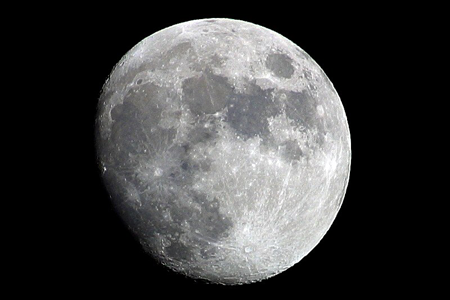The Moon Is 200 Million Years Younger Than Expected. Pock Marks Make You Look Rough, Eh?

The Moon looks rough. Pock marks, craters, what have you. Dull grey. Rough. Just from its looks I would say it’s something like 9-trillion years old. I’d be way, way off. However, even scientist-wunderminds were wrong in their estimation of the Moon’s age for a long time. The pig is 200 million years younger than previously thought.
io9:
The most commonly held theory of our Moon’s origins is one we’ve been talking about a lot lately, and it basically goes like this: Billions of years ago, an enormous collision occurred between a Mars-sized object (sometimes referred to as Theia) and the young Earth.
Amidst the fallout of this high energy collision was a heap of melted material called magma. When the magma cooled, it took the shape of the Moon we all know and love, solidifying into various mineral components in the process.
According to this “giant impact” model, the most ancient of the Moon’s minerals make up a rock type called ferroan anorthosite, or FAN for short. Numerous samples of FAN were recovered over the course of NASA’s six Apollo surface excursions, and have been studied extensively since being brought back to Earth.
Previous efforts to date FAN samples have yielded ambiguous results because the standard method of radiometric dating used to analyze the samples typically allowed scientists to only look at one isotopic system at a time. (An isotopic system can be thought of as an eyewitness that scientists can cross-examine to pinpoint the age of a rock. Trouble is, sometimes witnesses lie, or they remember incorrectly, or the scientists botch the cross-examination, so the more eye-witnesses you can gather to testify to the date and time of the “crime,” the stronger your scientific case will be.)
By bathing a FAN sample in a weak acid wash and making improvements to these standard radiometric techniques, the team of researchers – led by isotope geochemist Lars Borg – were able to round up not one, but three isotopic systems to pinpoint the age of the ancient lunar rock.
The collective testimony of the eyewitness isotopes, which is published online in the latest issue of Nature, suggests the FAN sample is a spry 4.36 billion years old (plus or minus three million years). According to Borg, these results indicate that the moon either solidified significantly later than scienctists once thought, or that the long-held belief that FAN samples did, in fact, solidify along with the Moon’s primordial molten ocean is incorrect. Either way, these findings have major implications for our understanding of the Moon and its history.
Interesting. What I find most awesome is that scientists are playing around with parts of the Moon. The sexy thing that hangs in the sky. They have some of it. Down here. On the Erf. Sick.



